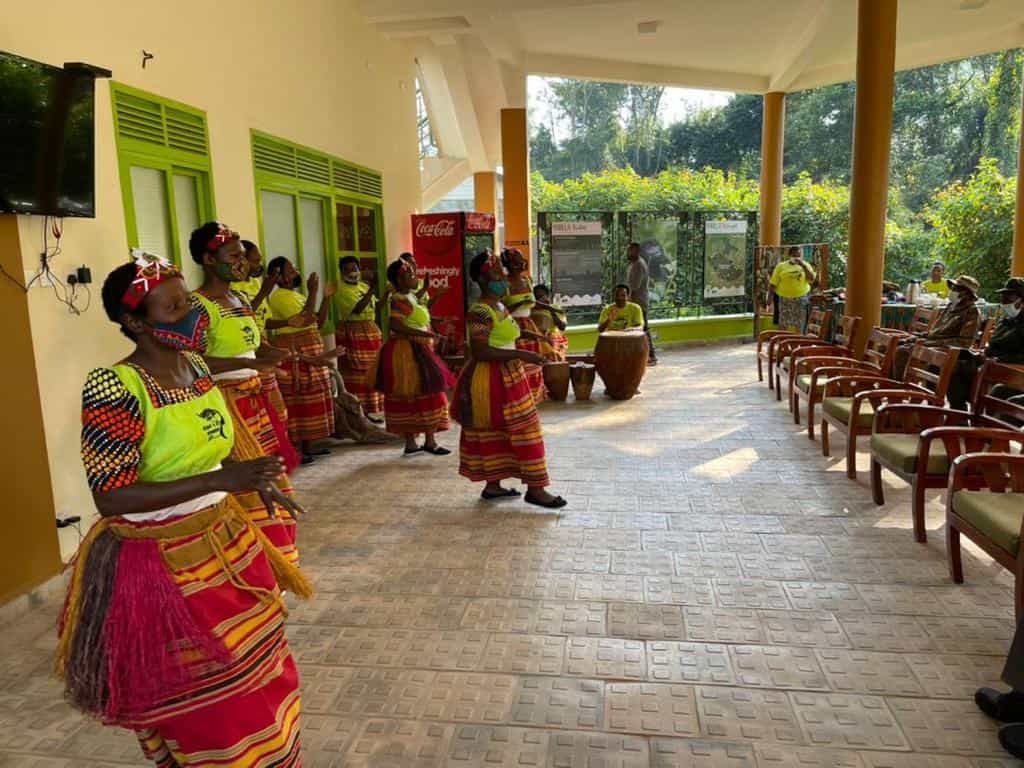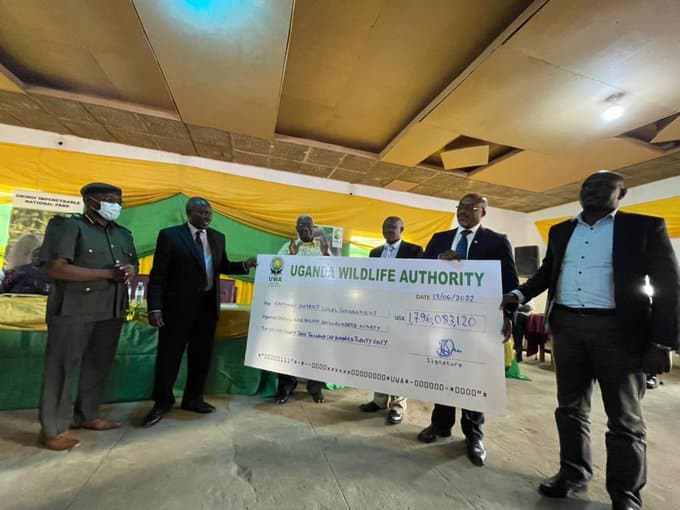Juna 24, 2022, Uganda Uprava za divlje životinje marked their silver jubilee in a green carpeted glamorous gala evening punctuated by vigorous traditional entertainment and good food and drink at The Kampala Sheraton hotel. The celebrations themed “Improved wildlife conservation and transformation of communities” reflect on the important economic, social, and ecological roles played by wildlife conservation in the transformation of communities.
Representing the honorable Minister of Tourism Wildlife and Antiquities,Hon. Tom Butime, was the Permanent Secretary, Doreen Katusiime, resplendently dressed for the occasion in green themed attire. Also in attendance were Uganda Wildlife Authority Board of Trustees including Chairman Dr. Panta Kasoma, UWA Executive Director Sam Mwandah, Stephen Masaba UWA Director Tourism and Business Development, Uganda Wildlife Education and Conservation Centre Executive Director Dr. James Musinguzi, Uganda Tourism Board CEO Lilly Ajarova, and her Deputy Bradford Ochieng, Principal Hotel and Tourism Training Institute Amori Miriam Namutose ,Chairman Exclusive Sustainable Tour Operator Association Boniface Byamukama, Civy Tumusiime Chairperson Association of Uganda Tour Operators Sarah Kagingo, Principal Press Secretary at Parliament of Uganda Godfrey Baluku, tourism influencer and Editor Africa Tembelea Gladys Kalema Zikusoka, Conservation Through Public Health Makerere University don Dr. Wilbur Aheebwa, Attilio Pacifici Ambassador of the EU to Uganda, among several other diplomats and stakeholders in the tourism sector.
Glamour aside, leading up to this milestone there have been several events that commenced with a media launch on June 1 – Conservation Conference on June 21 and Corporate Social Responsibility (CSR) involving cleaning of the neighboring Kamwokya Market in Kampala on June 23.
The UWA Board of Trustees led by their Chairman, Dr. Panta Kasoma, also took stock of their achievements beginning with visits mid-June to revenue sharing community initiatives in Bwindi Impenetrable Forest and Mt. Mgahinga National Parks to assess the successes and challenges in implementation of projects and chat out areas for better engagement.
They also visited staff in the Ruhija sector in Bwindi inspecting welfare issues and interacted on ways to better their work environment before rewarding themselves with a gorilla tracking experience in Buhoma sector.
The UWA Mandate
“To conserve, economically develop and sustainably manage the wildlife and protected areas of Uganda in partnership with neighboring communities and other stakeholders for the benefit of the people of Uganda and the global community.”
istorija
Uganda Wildlife Authority was established in August 1996 by the Uganda Wildlife Statue (1996) which merged Uganda National Parks and Game Department.
Dostignuća
Although the honorable Minister missed the climax on June 24, he was present to give an account of the history of UWA at the media launch where he said the last 25 years have witnessed a lot of transformation since the new institution was established leading to effective protection and conservation of wildlife in Uganda. It inherited challenges such as limited financial resources, lack of institutional policies, and demoralized staff that were inadequately remunerated.

UWA has built strong Governance Structures, Strategic Plans, Park General Management Plans, a Human Resource Manual, Financial Procedures Manual, Board Charter, Annual Operations Plans, and other operational and strategic policies that have been developed and are being implemented to ensure efficient running of the institution.
Uganda Wildlife staff numbers have grown from less than 1,000 in 1996 to just above 2,300. With the planned recruitment of rangers this month, the number will soon surpass 3,000. The organization is divided into 3 departments – namely, law enforcement, finance, and tourism. These have been broadened to include legal, investigations, intelligence, veterinary services, and engineering, as well as community conservation pointing to its growth and ability to adapt to changes in wildlife management.
Pointing to the need to curb the worldwide increase in wildlife crime becoming increasingly and highly sophisticated was the establishment of specialized units such as the Canine, Intelligence, Investigations and Prosecution, the Special Wildlife Crime Units, and a specialized court to handle wildlife crimes.
These have had a significant impact in combatting wildlife crime in the country earning UWA recognition in international fora such as CITES – Convention on International Trade in Endangered Species.
Encroachment on protected areas has been contained to a great extent through boundary marking of all protected areas and building capacity of staff in protected areas to contain illegal activities. With the exception of East Madi Wildlife Reserve and some sections of Mount Elgon National Park, all other protected areas have secure boundaries.
There has been a significant improvement in infrastructure across the board in all protected areas.
From a small office for headquarters, UWA acquired a new home at Plot 7 Kira Road and also constructed the high-rise Wildlife Towers at the original plot. In the protected areas, UWA has built a number of office premises as well as more than 1,700 staff units.
Visitor numbers to the protected areas have considerably increased from 85,982 visitors in 1996 to 323,861 in 2019 before the COVID-19 pandemic showing an increase of 237,879 visitors. This has resulted in tourism becoming the leading foreign exchange earner and bringing in, in excess of US$1.5 billion annually and contributing 9% of GDP.
The tourism sector was also employing 1.173 million jobs of which 670,000 being direct, accounting for 8% of total employment in the country.
Concession revenues in the national parks also considerably increased from UGX 345 million in 2006 to UGX 4.2 billion in 2019 before the pandemic.

Under the Uganda Wildlife Act, the Revenue Sharing Scheme provides for 20% of gate entry fees as a conditional grant to be shared with communities surrounding the protected areas disbursed through local governments. The funds are meant to ensure that communities feel the positive impact of conservation in their areas so that they can support wildlife conservation. Specific projects are developed by the communities themselves and agreed upon with UWA. In turn, communities contribute to conservation reducing human wildlife conflict thus creating harmony.
UWA has registered an increase of wildlife populations for most animal species. The mountain gorilla population in Bwindi Impenetrable National Park has increased from 257 in 1994 to 459 individuals in 2018.
Just a couple of days to the main event, UWA received a perfect gift with the birth of a healthy bundle of joy to adult female gorilla named Betina, a member of Mukiza family a new addition based at Ruhija.
The elephant population increased from about 1,900 in 1995 to 7,975 individuals in 2020; buffaloes from 18,000 in 1995 to over 44,000 by 2020; and the giraffe population from an estimated of 250 individuals in 1995 to over 2,000 in 2020. Burchell’s zebra population increased from an estimated 3,200 in 1995 to 17,516 by 2020. Rhinos that had been declared extinct in Uganda as of 1995 were re-introduced and now the population stands at 35 individuals as of 2022.
The honorable Minister attributes the increase in wildlife populations as a result of a combination of factors ranging from good policies of government, effective ecosystem management, and improved capacity of the UWA to provide security for the wildlife and involvement of communities on wildlife conservation activities.
UWA has over the years excavated over 500 km of trenches along selected park boundaries including Queen Elizabeth, Kibale, and Murchison Falls National Parks In order to mitigate and reduce human wildlife conflict. They are 2 meters wide by 2 meters deep trenches and are relatively effective against large mammals. More than 11,000 bee hives have also been procured and distributed to different community groups. The hives have been installed along the protected area boundaries. “The stinging and buzzing sound of the bees irritates and scares away the elephants while the honey collected from the hives is sold to generate income and enhance community livelihoods,: added Mwandah.
A state-of-the-art Biosafety Level 2 laboratory was constructed at Mweya in Queen Elizabeth National Park. The laboratory is able to diagnose and confirm a range of animal diseases (both wildlife and livestock) from viral, bacterial, fungal, and protozoa. The laboratory can handle investigations of human diseases, too. A lower-level Biosafety level 1 laboratory was also constructed in Murchison Falls National Park to support wildlife disease management through prevention, detection. and response.
UWA has a developed capacity to carry out translocation of wildlife within and outside its protected areas, translocating over 601 wild animals in the last 10 years, notably giraffe, impala, zebra, Jackson’s hartebeest, giant forest hog, eland, waterbuck, crocodile, and topi, etc. The objectives range from addressing human-wildlife conflicts, conservation education, range expansion, species diversification, tourism, and biological management of expansive vegetation especially Acacia hockii and breeding. By 2020, the translocated animals were estimated to have multiplied to over 1,530 individuals.
What is the vision for the next 25 years?
Butime cautions that for the next 25 years “We should, however, not lose sight of the need to even do more to address human wildlife conflicts and reduce the poaching incidents that remain high.”
He calls upon all Ugandans and conservation and tourism partners to promote and participate in the events above in celebration of this great wildlife conservation milestone of Uganda Wildlife Authority.
Following the gala, the very busy UWA Communications Manager, Hangi Bashir, told eTurboNews: “We want to consolidate the gains from the last 25 years, to tackle Human Wildlife conflict, adoption of modern technology in conservation for example. Why must we have 10,000 rangers instead of field cameras? Currently we are using earth ranger solution′ of detecting crime in real time in Murchison Falls where we monitor the park on screen and deploy rangers in case of an incident. We shall also adopt drones and camera traps as we roll out to the other parks.”

When pressed by our eTN correspondent at the launch, Tourism and Business Manager Stephen Masaba stopped short of banning single use plastics in protected areas but emphasized that the protection of the environment and natural resources is everyone’s responsibility. He said that UWA has stiff fines on littering in the parks of up to UGX X 100,000 (approximately US$30). He added: “For the next 25 years, UWA wants to receive 1 million visitors. Before COVID-19 we had 325,000 visitors. To achieve this we have identified the need to put [in] high-end lodges, and [we] will continue to advertise affordable and luxury accommodation, and to protect the resources we shall ensure sustainable practices that will ensure that the wildlife and resources are protected and if anything happens, we have learnt our lessons in the last 2 years, and we shall use stronger methods to ensure that we do not jet any beatings from a COVID-like situation.”
“The formation of Uganda’s national parks was ironically credited to unlikely conservation allies’ when rinderpest and sleeping sickness forced communities to sadly perish and vacate. Murchison Falls, Uganda’s largest national park (3,893 sq km), and Queen Elizabeth National Park (1978 Sq km) were established in 1952.
“The year 2006 was another milestone celebrating 100 years since the first scientific expedition to the peak of the 5109M Ruwenzori “Mountains of the Moon” ranges led by Italian Luigi Amedeo di Savoy, Duke of Abruzzi. This was with a repeat of the hike by Ugandan and Italian descendants from Alpine brigade dubbed “in the footsteps of the duke.” A delegation led by this writer on behalf of Uganda Tourism Board also showcased the centenary event at BIT Milan Expo in February that year before the final ascent in June.
“Currently, UWA manages 10 national parks, 12 wildlife reserves, and 5 community wildlife areas. It also provides guidance to 14 wildlife sanctuaries and is responsible for the management of wildlife both in and outside protected areas.”
In recent years, activists championed by Association for the Conservation of Bugoma Forest ACBF, Climate Action Network Uganda, among others have called for the establishment of 41,000 sq km Bugoma Forest Central Reserve in western Uganda to be upgraded into a national park to save it from wanton destruction since Hoima Sugar works’ onslaught of the forest for sugar growing since Bunyoro Kitara kingdom controversially leased 22 sq miles to the factory in 2016.
Pian Upe Wildlife Reserve in Eastern Uganda is also proposed for upgrading to national park status which shall guarantee better protection and management under UWA’s resources and expertise.
Into the next 25 years and beyond, we must not forget to celebrate and recognize the rangers who have paid the ultimate price in protecting wildlife and habitats in the name of conservation, all in the face of threats from the elements of wildlife but mainly from self-seeking fellow human beings.
ŠTA UZIMATI IZ OVOG ČLANKA:
- Although the honorable Minister missed the climax on June 24, he was present to give an account of the history of UWA at the media launch where he said the last 25 years have witnessed a lot of transformation since the new institution was established leading to effective protection and conservation of wildlife in Uganda.
- Pointing to the need to curb the worldwide increase in wildlife crime becoming increasingly and highly sophisticated was the establishment of specialized units such as the Canine, Intelligence, Investigations and Prosecution, the Special Wildlife Crime Units, and a specialized court to handle wildlife crimes.
- “To conserve, economically develop and sustainably manage the wildlife and protected areas of Uganda in partnership with neighboring communities and other stakeholders for the benefit of the people of Uganda and the global community.























